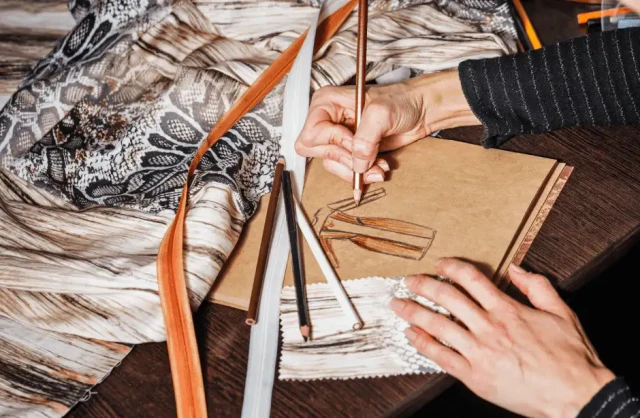Italian fashion is a powerful symbol of artistic creativity and innovation that has impacted the global stage. Its history is a vibrant narrative of cultural development, highlighting the interplay of fabric and design with Italy's historical and artistic heritage.
Explore the rich history of Italian style as we journey through its pivotal eras, from the opulent Renaissance and flamboyant Baroque period to the revolutionary impact of modern design houses that dominate today's runways. Join us as we delve into Italy's captivating saga and gain insight into how it influences and is influenced by the fashion world.
Historical beginnings and decade-specific evolution
The Italian fashion house has always been known for its exceptional quality and innovative designs, mirroring larger societal shifts and economic factors. In this section, we'll explore the influential periods of the 1920s, 1950s, 1970s, and 1980s, each representing a significant advancement in Italian fashion.

- 1920s Italian fashion influence: In the 1920s, Italy experienced an economic resurgence after the aftermath of World War I. This period marked a significant revival in fashion, symbolising renewal and modernisation. Notable designers such as Elsa Schiaparelli emerged during this time, blending Italian artisanship with the avant-garde trends of Paris. The era also transitioned towards more comfortable yet refined women's attire, departing from the constricting corsets of earlier years.
- 1950s Italian haute couture: During the 1950s, Italian haute couture experienced a significant surge, establishing Milan and Rome as prominent fashion hubs. Visionary designers like Giovanni Battista Giorgini organised the inaugural Italian fashion shows, captivating international interest. The era's economic prosperity facilitated the use of abundant materials and elaborate designs, reflecting Italy's post-war resurgence.
- Milan fashion 1970s evolution: The 1970s in Milan were characterised by political turmoil and cultural advancement, which significantly impacted the fashion scene and led to more daring and experimental designs. This period witnessed the emergence of ready-to-wear collections, which made fashion more attainable and mirrored the societal transition towards casual and functional clothing.
- 1980s Italian designer brands: The 1980s marked a significant period for Italian designer brands, as a thriving economy and growing international interest in luxury goods propelled the likes of Versace, Dolce & Gabbana, and Prada to fame. Renowned for their extravagant designs and impeccable craftsmanship, these fashion brands showcased Italy's unique talent for combining classic elegance with modern style, further cementing the country's position as a leading force in the fashion world.
How iconic designers and their brand impact fashion
Italian fashion has always been known for its luxury, style, and craftsmanship. The impact of renowned designers such as Gucci, Versace, and Armani is felt in Italy and globally, as they have shaped fashion trends and defined luxury branding.

- Gucci and Italian fashion: Established in 1921, Gucci played a pivotal role in transforming Italian fashion by blending traditional artisanship with innovation. The brand reached the pinnacle of its influence in the 1960s, redefining luxury while upholding exceptional craftsmanship. Even today, Gucci continues to shape the fashion landscape, leaving an indelible mark on Italy's contemporary style and cultural heritage.
- Versace and Italian style evolution: Established by Gianni Versace in 1978, this label is renowned for its daring and luxurious style, featuring vibrant prints, opulent fabrics, and alluring designs. Versace significantly contributed to the global popularisation of Italian fashion, notably through celebrity endorsements and iconic red-carpet appearances. The brand's skilful fusion of popular culture with high fashion has ensured its enduring relevance and influence.
- Armani's impact on 1980s Italian fashion: Giorgio Armani revolutionised the fashion industry in the 1980s by introducing the deconstructed jacket, a garment that offered a more relaxed approach to luxury attire. Armani's designs prioritised simplicity and elegance, diverging from the prevalent trend of excessive embellishments. His impact extended beyond fashion, encompassing lifestyle and design, establishing Armani as the epitome of Italian luxury.
The work of each of these designers has made a unique and lasting impact on both Italian and global fashion. Their contributions continue to influence current and future trends, showcasing the rich history of Italian luxury brands and their enduring influence on the fashion industry.
Cultural and global influence
Italian fashion is known for its exceptional craftsmanship, creative designs, and rich cultural heritage. Its influence extends beyond Italy, impacting worldwide art, culture, and cinema. This exploration delves into the connection between Italian fashion, these artistic elements, and its global influence.

- Representation in cinema: Italian fashion has always been a captivating presence in movies, representing luxury, elegance, and the essence of the Italian lifestyle. Timeless classics such as La Dolce Vita and Roman Holiday feature iconic Italian fashion, contributing to Italy's reputation as a global fashion hub.
- Influence on global trends: Italian designers such as Giorgio Armani, Versace, and Prada have significantly impacted global fashion trends. Their creations are regularly showcased in international fashion events and have a lasting influence on styles worldwide. Milan Fashion Week mainly serves as a platform for designers to introduce trends far beyond the fashion industry.
- Role in art and culture: Italian fashion extends beyond mere clothing; it is a form of creative expression that mirrors shifts in society and cultural influences. It intersects with various art forms, shaping and being shaped by visual arts, music, and literature, enriching our comprehension of cultural stories and identities.
- Enduring global impact: Italian fashion's global impact is significant, as Italian brands and aesthetics dominate fashion conversations and retail selections worldwide. The unique ability of Italian fashion to blend tradition with innovation has a universal appeal, impacting not just the fashion industry but also everyday street style and high couture in numerous countries.
The unique combination of artistry and innovation in Italian fashion continues to influence and shape global fashion trends, demonstrating its enduring and far-reaching impact.
What are the key events and modern developments
Italian fashion has long been a global style icon, celebrated for its exquisite fabrics, flawless artisanship, and groundbreaking designs. As the industry progresses, significant events and contemporary advancements continue to influence its path. Let's delve into the impactful occurrences and trends shaping the world of Italian fashion.

- History of Milan Fashion Week: Milan Fashion Week, founded in 1958, has played a crucial role in solidifying Italy's position as a global fashion hub. It provides a stage for seasoned designers and up-and-coming talent to present their latest designs. This semi-annual event spotlights current fashion trends and mirrors the ever-evolving landscape of the Italian fashion sector.
- Evolution of Florence's Pitti Uomo: Since 1972, Pitti Uomo has been a game-changer in men's fashion, emphasising men's clothing and accessories. This renowned event, held in Florence, is known for shaping international men's fashion trends and thoroughly exploring innovative and timeless styles in the industry.
- Sustainability in modern Italian fashion: Modern Italian fashion now emphasises sustainability more. Designers and brands are incorporating eco-friendly practices, focusing on minimising waste and utilising sustainable materials. This change is primarily influenced by increasing consumer expectations for environmentally responsible products, reshaping the industry's approach to design and production.
- Technological advancements in Italian fashion design: The modern Italian fashion industry heavily relies on technology to drive innovation. By integrating 3D printing and artificial intelligence in garment production, designers can enhance efficiency and creativity in their design processes. Italian fashion designers are leading the way in utilising technology to push the boundaries of what is achievable in the fashion industry.
The noteworthy events and recent progress in Italian fashion honour its heritage and point to an innovative, sustainable future.
The future of Italian fashion in global markets is as promising as its illustrious past. With a rich legacy, Italian fashion continues to set benchmarks in style and sophistication. As the industry evolves, it consistently adapts to new trends while maintaining its distinct identity. This enduring influence invites fashion enthusiasts and industry insiders alike to ponder how Italian style will continue to shape global aesthetics.



